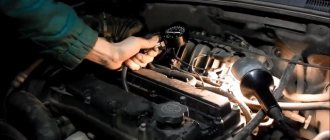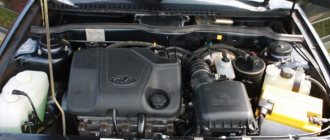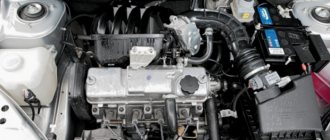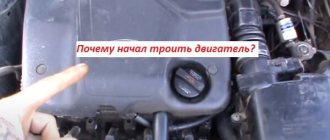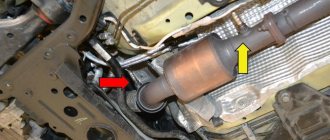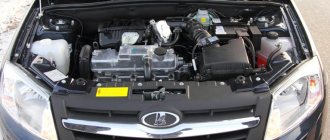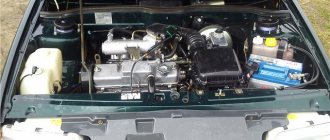“Trippling” of the VAZ-2109 engine is a term denoting a malfunction of the power plant that occurred as a result of failure and interruptions in the operation of one of the cylinders. This breakdown is quite common and occurs in engines with both carburetor and injection power systems.
Signs
“Tripling” appears on the VAZ-2109 in the form of:
- Unstable motor operation.
- Strong vibration.
- Power drops.
- Difficulty starting.
- The appearance of “pops” in the exhaust system.
“Tripping” is not a critical engine failure, and the car can be driven, at least to get to the repair site. But you shouldn’t delay repairs, since improper operation of one of the engine cylinders will ultimately lead to serious problems.
Let's start with why the engine triples, and not “doubles” or “quadruples”, for example :-)
The fact is that quite recently most engines had four cylinders, probably no one would have believed that there could be six, eight or twelve 30 years ago, but oh well... In general, when one of the four cylinders stopped working, then the workers There were only three cylinders left, and the sound of the engine was seriously changing. This phenomenon is called engine throttling, that is, the engine runs on three cylinders with a characteristic sound. Years passed, the number of cylinders changed, but the term troit remained unchanged.
Identification of an idle cylinder
The method for identifying a bad cylinder depends on the type of engine power system.
In carburetor engines, the determination of a failed cylinder is carried out experimentally. The essence of the method is to turn off each cylinder one by one by removing the tip of the high-voltage wire from the spark plug while the unit is running.
The check should begin with the 1st cylinder on a warm engine and with the speed set at 1500 rpm. If, after removing the tip, the speed drops significantly (the engine stops altogether, since as a result 2 cylinders will be switched off), the 1st cylinder is working normally.
Next, the test is carried out on the following cylinders. If the cylinder is not running, removing the tip will not affect the operation of the motor. After turning off the “drawdown” there will be no revolutions.
This test method is simple and allows you to accurately determine which cylinder is not working. But when doing it, follow safety precautions. High-voltage wires carry electrical impulses with high voltage but low current. These impulses will not cause damage to health, but the sensations are not pleasant.
As for the VAZ-2109 engine with an injector, the experimental method should not be used here (so as not to affect the operation of electronic systems). On such engines, the determination of an inoperative cylinder is carried out by scanning the ECU for errors. Interruptions in the operation of the motor are monitored by electronic systems and recorded in the form of error codes, by deciphering which we find out what caused the disruption of the normal functioning of the unit.
Video: VAZ-2109. The engine is shaking!
Sometimes there are cases when the engine only starts “cold” or “hot”
In this case, the valves are most often the cause; they may have become misadjusted. Valve adjustments should be carried out every 20 thousand km. The essence of this problem is that most likely the valves have large gaps, but after the engine warms up they become smaller and the engine does not leak. The same applies to “hot” conditions - when the engine is cold, the valves are normal and the engine is running smoothly, but after warming up, the unregulated valve is clamped, as a result, the cylinder stops working and the engine begins to stall.
I will end here, I hope my article was useful to you and you found the reason for the engine tripping. If not, seek help from specialists. If you know other reasons for engine tripping, I’ll be happy to hear them, use the comment form.
Checking the ignition system
The reason that the VAZ-2109 engine “troubles” is the ignition system. Due to its incorrect operation, the combustion process of the air-fuel mixture is not observed in one of the cylinders, which leads to unstable operation of the engine, severe vibration, and a drop in power.
Interruptions in the ignition system, due to which “triple” occurs, give:
- Candles.
- High-voltage wires and their tips.
- Contacts of the distributor cover (distributor).
- Hall Sensor.
These items should be checked in the same order.
Candles are one of the most common causes of tripping. Exhausted life, incorrect clearance, “breakdown” of the housing and penetration of the impulse to ground - these faults of the spark plug lead to failure or malfunction, which affects the operation of the motor.
You can verify that a spark plug is broken by replacing it with a known good one or swapping it with a spark plug from another cylinder. Replacing the spark plug can eliminate the malfunction of the power unit.
In addition to the spark plug, you should check the condition of the contact in the tip (which is put on the contact nut of the spark plug). It is made of copper and oxidizes over time, which leads to disruption of contact between the wire and the spark plug, and causes “triple” to appear.
In search of the cause, the high-voltage wires are checked next. Over time, the braiding of these wires loses elasticity and cracks, which is why voltage pulses “break through” to the ground, not reaching the spark plug.
A simple way to check the wires is to start the engine at night and open the hood. In the dark, “breakdowns” in the form of sparks are visible. If sparks are noticeable, replace the wires.
Next, look at the distributor cap and the slider. Gradually, the contacts on the slider and in the lid wear out, and they may also oxidize, which leads to loss of contact and interruptions in the operation of the spark plug.
Due to a malfunction of the Hall sensor, there is a failure in the formation of pulses supplied to the switch. Because of this, the operation of the ignition system is disrupted, in which the pulse from the coil to the distributor is missed, and from it to the spark plug.
Do not forget that an incorrectly set ignition timing is another reason for engine tripping. Therefore, in search of the cause, we be sure to check the setting of this angle and carry out adjustment work.
How to fix the problem?
After the reasons why the VAZ 2114 engine is tripping have been determined , it is necessary to act depending on the situation:
- If there are problems in the ignition system, replace the broken spark plug or high-voltage wires.
- If the reason is in the fuel injection system or compression level, clean the injectors with ultrasound, adjust or replace the valves, air filter, check the position of the timing belt.
If these actions do not lead to results, you need to check and, if necessary, replace:
- Control block;
- crankshaft position sensor;
- oxygen sensor.
Thus, engine tripping is a common breakdown that, with experience and skillful hands, can be corrected on your own. If the cause of the tripping is a breakdown in key systems (control units) or there is no special equipment at home (for example, for cleaning injectors with ultrasound), it is recommended to contact a service station.
Malfunctions of the CPG and timing belt
Problems in the cylinder-piston group and gas distribution mechanism are another reason for interruptions in engine operation. This malfunction occurs when:
- occurrence of rings;
- piston burnout;
- burning of the valve plates and their seats.
Malfunctions of the CPG and timing, due to which the engine “trips” appear, are determined by measuring compression in the cylinders. A cylinder that operates intermittently has a lower compression rate than the rest.
Next, we establish the reason for the drop in compression. To do this, pour 20-30 g through the spark plug hole of the cylinder. engine oil, after which we take compression measurements again.
An increased compression ratio indicates the occurrence of rings. We eliminate this problem by decarbonizing the motor.
If the repeated measurement again shows low compression, you will have to remove the cylinder head to determine the cause of the malfunction.
The reason for the “triple” of the power unit can also be a breakdown of the cylinder head gasket. Due to this malfunction, a loss of compression occurs in the cylinder due to depressurization of the combustion chamber.
What are the consequences of tripling?
First of all, you will lose power no matter how you look at it, and the engine will not run on three cylinders as well as on four. Everything seems clear here. The second sign that the engine is malfunctioning is vibration and a characteristic “trembling” that comes from the engine compartment. The third characteristic sign that the engine is malfunctioning is excessive fuel consumption and the smell of gasoline in the exhaust gases. Do you think that's it? No, as they say, this is just the beginning; if the fault is not detected and corrected in time, big trouble awaits you.
I'll explain why. When one cylinder does not work, combustion of the fuel-air mixture does not occur in it, which means it all accumulates in the cylinder, then, diluted and mixed with oil, goes into the crankcase. The more fuel goes into the crankcase, the more the oil will be diluted, its viscous and lubricating properties will completely disappear over time. As a result, you will get a significant reduction in compression, critical wear of the piston and rings, which will rub in the combustion chamber without a drop of lubrication, creating scuffing and abrading the cylinder walls. In the end, engine overhaul is simply inevitable.
Why does a car run on gas?
Quite often a problem arises when a car idles on gas with a cold engine, but when switching to gasoline everything works fine. There are few reasons for such a malfunction. The most common of them:
Damaged diaphragm in the gearbox
- clogging of gas filters;
- loose or loose connections of gas installation pipes;
- malfunctions of the gas reducer - damaged or contaminated membrane, poor-quality or used seals;
- partially or completely inoperative gas injectors. As a rule, the main reason for their malfunction is contamination;
- Incorrect setting of HBO.
Valve mechanism
The last place to look for a problem is the valve mechanism and piston system. Usually, in this case, the car owner is advised to contact a car service center.
But the VAZ 2106 engine has a fairly simple design, so it’s easy to figure out and identify a fault of this nature, although it will take half a day.
To simultaneously inspect the condition of the cylinders and valves, you will have to dismantle the cylinder head. To do this, it is worth removing the carburetor, manifolds and other equipment from the engine that is attached and will interfere with the dismantling process. Then, it is worth inspecting the condition of the intake and exhaust valves, as well as the valve seats.
The cylinder head may need major repairs. Also, it is worth looking at the condition of the pistons and oil rings. The pistons could burn out or the engine's life would be exhausted. To fix it, it is necessary to overhaul the engine.
Troubles VAZ engine injector
The most capricious model regarding tripping is installed on the VAZ 2109/99. But also on newer modifications such as 2110, 2112 and 2115, similar incidents occur. Due to the presence of design differences between the engines, the further description will follow a schematic principle.
Spark plugs and high voltage wires
Before all subsequent manipulations, it is necessary to check the functionality of the spark plugs. A damaged element may not produce a spark with the required power. This is the reason for the refusal. Checking and repairs are performed as follows:
- Use a special key to unscrew one spark plug from its seat;
- Visually assess the condition of the element. There should be no carbon deposits or clouding on the working part, the electrode should be intact;
- Place the body of the part against the engine cover;
- Turn on the ignition and crank the starter. If the spark plug is working, a powerful spark should be produced when the engine is cranked.
The procedure must be performed for all four cylinders. The damaged part is replaced with a new one. Note! There is an easier way to check. With the engine running, you need to remove the spark plug cap. In this case, if the element is working properly, the power plant will begin to stall. If there are problems, the internal combustion engine will not respond.
If replacing the spark plug does not produce results (no spark appears), you need to test the armor wires:
- A multimeter is connected to the cable. The device readings should be ± 5 ohms. If the deviation from the standard is more than 10%, the part is changed;
- The second method of verification (handicraft). In place of the suspicious wire, an element from the adjacent cylinder is installed and manipulations with the spark plugs are repeated.
Compression
Compression failure can also be a decisive factor in the loss of engine power or failure of one of the cylinders. The check is performed in the following sequence:
- Unscrew the spark plugs;
- Connect the compression meter to the socket;
- Crank the starter for 1-2 seconds until the maximum indicator is displayed on the device;
- Carry out the operation for all 4 pistons.
The standard for compression of VAZ engines is 11-12 Atm. In this case, a difference in indicators of more than 10% is unacceptable. If there is strong dissonance (one of the 4 boilers shows 7-8, while the others show 11-12), urgent engine repair is required. To more accurately determine the “root” of the breakdown, you can add 5 ml of engine oil to the combustion chamber and measure the pressure again. If the device information has changed, the cause of the breakdown is sunken rings or ellipse of the cylinder. In the case of similar data, adjustment or replacement of the valves is required.
Electronic sensors
The next possible reason for a VAZ 2107 and others like it to fail is the failure of one or more sensors located on the engine. The units themselves cannot be repaired and, if they fail, must be completely replaced.
Mass air flow sensor
The mass air flow sensor is responsible for the correct dosage of air masses supplied to the power plant. If it does not work properly, tripping, jerking when moving, or an unstable set of revolutions is possible.
DPKV
The crankshaft position sensor also affects a similar problem. From the readings of this device, the on-board computer determines at what moment it is required to fire a spark and pour a portion of fuel into the combustion chamber. If the part does not work correctly, flooding of spark plugs, tripling or even doubling of the power plant may occur.
DFT
The phase distribution sensor is installed only on cars with 16 cells, if the injection VAZ has 8 valves, you don’t have to look here. The on-board computer reads information from the sensor and determines when and how much gasoline to inject into the manifold. In fact, the device duplicates the operation of the DPKV.
ECM
This block relates to engine control equipment. The faulty part can only be determined using computer diagnostics. It is here that information is collected from all sensors, and the composition and amount of the air-fuel mixture is determined. Air supply system Additionally, it would not be superfluous to check the integrity and serviceability of the air line. If the filters are clogged, the cylinders may not have enough air, which is an indirect cause of tripping.
Injectors
The main root of evil is often the pressure nozzles, which are responsible for supplying fuel directly into the combustion chamber. In 90% of cases, the cause lies in blockages. Low-quality gasoline may contain small mechanical impurities or water. In the first case, a speck may get through the filters and clog the thin opening of the part. The second option is oxidation of the walls of the gas tank with the subsequent spread of rust. The consequence is that the clogged hole does not allow gasoline into the engine in the required quantity. For diagnostics, the injectors are dismantled and their condition is checked. Broken or deformed elements are replaced with new ones.
Fuel
In 70% of cases, this problem is the primary source of injector malfunction. If after the next refueling the VAZ engine troits, the root is probably hidden here.
To fix the problem, you need to drain the low-quality gasoline and check the filter elements. The inserts are equipped with thin membranes that trap dirt and foreign impurities. If there are coarse particles in the fuel, under pressure they can break through the walls of the filters and penetrate further. It is also necessary not to forget about the scheduled replacement of VAZ filters. It must be performed every 20,000 km.
Air intake
Another component where a malfunction may be hidden is the air supply, and in the case of Zhiguli, an air filter that is simply clogged. The recommended service life of the filter element is 20,000 km. But this indicator also depends on the region of operation of the vehicle, as well as the time of year.
Found a problem with the engine tripping on cold start
For almost a year I struggled with poor starting of the internal combustion engine when cold, which I described in my first logbook. Unhealthy starting of the internal combustion engine when cold UAZ Patriot and at first I thought that this problem had been solved, but after a week the symptoms appeared again and in the future they manifested themselves somehow. stronger then weaker.
Now I’ll describe again what the symptoms were and what I changed during all this time. Symptoms: — during a cold start (mostly in the morning or for long periods of inactivity), the revolutions immediately rose to 1200-1500, then dropped sharply to about 500, while it revved heavily, but all cylinders were working! because when I removed the terminals from the coils, the operation of the engine changed one by one; all of them were the same. — at first, it was enough to turn off the car (after 5-10 seconds of starting it) and after starting it, the engine began to run smoothly. Over time, it began to work normally only after 3-4 times, and then generally until the temperature needle creeps up.
— during the first launch and its tripping, I tried to press the gas pedal or drive for a ride, but very strong dips appeared. And if the pedal was pressed and not released, there were long failures and after a few seconds, about 3-4, the UAZ exploded and also after 3-4 seconds it failed again. After this cycle, with a little adjustment, it began to drive normally and then its performance leveled off to normal. — and most importantly, the check light did not light up! What helped to remove the symptoms so that the engine would start normally and you could immediately start driving without failures: as I later realized and what again misled me was to forcibly enrich the engine mixture 1) reset the DBP chip; 2) reset the Coolant Temperature chip in the thermostat housing; 3) remove the phase sensor chip (camshaft). For almost a year, I periodically removed the chip so that it would start normally (mainly in winter). What I replaced and checked over the entire time in order to cure the UAZ: 1) knock sensor; 2) DBP (absolute pressure sensor); 3) coolant temperature sensor; 4) spark plugs at every oil change; 5) nozzles; 6) out of necessity, I had to replace 2 timing chains, at the same time I set the sprockets to the ideal phase and set the angles as per the book 20/19. 7) 4 SOATE ignition coils; I just checked the phase sensor, fuel pump and pressure relief valve in the fuel system and they were in good working order. As I wrote above in my first log, after replacing the injectors, these symptoms went away, but I won’t be back for long. Replacing the remaining engine elements did not change its operation. I went to one diagnostician who couldn’t really tell me anything, he asked me to leave the car indefinitely to overhaul the entire engine in order to figure it out and give me a brush, for which he was tactfully sent to... th. In general, I’m repairing a UAZ myself; I don’t trust such work to these hands-on guys, and I’m also interested, and in general, the UAZ is the kind of car that you need to be able to sort it out yourself in spilled conditions. Every time I checked everything, I started checking everything again in the hope that I had missed some detail. I read a lot of literature, understood this engine inside and out, but I still couldn’t cure it. A week ago, standing stupidly in front of the engine, looking at it like a ram at the gate, one piece of shit caught my eye, which I didn’t even pay attention to. Adsorber, his mother, I couldn’t imagine in any way that all the crap was in it. At first I simply removed the chip from the adsorber valve, drove it like that for a week, it started well, there were no failures, but it was slightly under pressure at startup. And today I decided to take it off and throw it away so as not to see it anymore and free up space under the hood. I removed the canister itself, disconnected the canister valve block and plugged the hole under the receiver near the throttle valve and the hose that came from the tank. After these manipulations, the engine stopped running altogether, started to start smoothly (I couldn’t even think that it could work like that), the warm-up rpm is exactly 1200, the tachometer needle doesn’t twitch at all, after the engine warms up it smoothly drops to 800 rpm. Overall, I’m glad that I found the reason, even though I had to change a lot of spare parts (which went to Zip) and quite a bit of time passed, but I cured the UAZ. I’ve been happy for a week now, and this time for some reason I’m 100% sure that it won’t happen again)) And I still need to flash my brains for EURO-2, cheating won’t really help! I hope this article helps someone!
And if the pedal was pressed and not released, there were long failures and after a few seconds, about 3-4, the UAZ exploded and also after 3-4 seconds it failed again. After this cycle, with a little adjustment, it began to drive normally and then its performance leveled off to normal. — and most importantly, the check light did not light up! What helped to remove the symptoms so that the engine would start normally and you could immediately start driving without failures: as I later realized and what again misled me was to forcibly enrich the engine mixture 1) reset the DBP chip; 2) reset the Coolant Temperature chip in the thermostat housing; 3) remove the phase sensor chip (camshaft). For almost a year, I periodically removed the chip so that it would start normally (mainly in winter). What I replaced and checked over the entire time in order to cure the UAZ: 1) knock sensor; 2) DBP (absolute pressure sensor); 3) coolant temperature sensor; 4) spark plugs at every oil change; 5) nozzles; 6) out of necessity, I had to replace 2 timing chains, at the same time I set the sprockets to the ideal phase and set the angles as per the book 20/19. 7) 4 SOATE ignition coils; I just checked the phase sensor, fuel pump and pressure relief valve in the fuel system and they were in good working order. As I wrote above in my first log, after replacing the injectors, these symptoms went away, but I won’t be back for long. Replacing the remaining engine elements did not change its operation. I went to one diagnostician who couldn’t really tell me anything, he asked me to leave the car indefinitely to overhaul the entire engine in order to figure it out and give me a brush, for which he was tactfully sent to... th. In general, I’m repairing a UAZ myself; I don’t trust such work to these hands-on guys, and I’m also interested, and in general, the UAZ is the kind of car that you need to be able to sort it out yourself in spilled conditions. Every time I checked everything, I started checking everything again in the hope that I had missed some detail. I read a lot of literature, understood this engine inside and out, but I still couldn’t cure it. A week ago, standing stupidly in front of the engine, looking at it like a ram at the gate, one piece of shit caught my eye, which I didn’t even pay attention to. Adsorber, his mother, I couldn’t imagine in any way that all the crap was in it. At first I simply removed the chip from the adsorber valve, drove it like that for a week, it started well, there were no failures, but it was slightly under pressure at startup. And today I decided to take it off and throw it away so as not to see it anymore and free up space under the hood. I removed the canister itself, disconnected the canister valve block and plugged the hole under the receiver near the throttle valve and the hose that came from the tank. After these manipulations, the engine stopped running altogether, started to start smoothly (I couldn’t even think that it could work like that), the warm-up rpm is exactly 1200, the tachometer needle doesn’t twitch at all, after the engine warms up it smoothly drops to 800 rpm. Overall, I’m glad that I found the reason, even though I had to change a lot of spare parts (which went to Zip) and quite a bit of time passed, but I cured the UAZ. I’ve been happy for a week now, and this time for some reason I’m 100% sure that it won’t happen again)) And I still need to flash my brains for EURO-2, cheating won’t really help! I hope this article helps someone!

